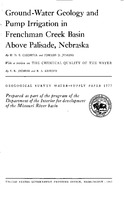This report describes the geography, geology, and ground-water resources of that part of the Frenchman Creek basin upstream from Palisade, Nebr., an area of about 4,900 square miles. The basin includes all of Phillips County, Colo., and Chase County, Nebr., and parts of Logan, Sedgwick, Washington, and Yuma Counties, Colo., and Dundy, Hayes, Hitchcock, and Perkins Counties, Nebr. The land surface ranges from nearly flat to rolling; choppy hills and interdune saddles are common in the areas of dune sand, and steep bluffs and gullies cut the edges of the relatively flat loess plateaus. Most of the basin is drained by tributaries of Frenchman Creek, but parts of the sandhills are undrained. Farming and livestock raising are the principal industries. Irrigation with ground water has expanded rapidly since 1934.
The rocks exposed in the basin are largely unconsolidated and range in age from Pliocene to Recent. They comprise the Ogallala formation (Pliocene), the Sanborn formation (Pleistocene and Recent?), dune sand (Pleistocene and Recent), and alluvium (Recent). The rocks underlying the Ogallala are the Pierre shale (Late Cretaceous) and the White River group (Oligocene). The Pierre shale is relatively impermeable and yields little or no water to wells. The White River group also is relatively impermeable and yields little or no water to wells; however, small to moderate quantities of water possibly may be obtained from wells that penetrate fractured or 'porous' zones in the upper part of the White River group or permeable channel deposits within the group. The Ogallala formation is the main aquifer in the basin and yields moderate to large quantities of water to wells. The Sanborn formation and the dune sand generally lie above the water table, but in areas of high water table the dune sand yields small quantities of water to wells for domestic and stock supplies. The alluvium, which includes the low terrace deposits bordering the major streams, yields small to large quantities of water to wells.
The ground-water reservoir is recharged only from precipitation on the basin. Of the average annual precipitation of 19.5 inches, about 0.9 inch infiltrates to the water table, thereby contributing about 220,000 acre-feet of water annually to the ground-water reservoir. About 81 million acre-feet of water that could drain under gravity, and thus theoretically is available to wells, is held in groundwater storage in the basin. Water is discharged from the ground-water reservoir by wells, evaporation and transpiration, springs, seepage into streams, and movement into adjacent areas to the east and southeast. Most of the domestic, stock, and irrigation water supplies and all the public supplies are pumped from wells.
During 1953, 96 wells were used to irrigate 10,000 acres of land with 19,000 acre-feet of water. About 34,000 acre-feet of water is evaporated and transpired annually in the valleys of the main streams and in areas of shallow water table in the sandhills.
From the projection of base-flow measurements made during 1952, it was estimated that the average annual flow of Frenchman Creek into the reservoir above Enders Dam is about 57,000 acre-feet. By similar determinations, the average annual flow of Frenchman Creek at the gaging station at Palisade, Nebr., about 22 miles downstream from Enders Dam, is about 76,000 acre-feet, and the flow of Stinking Water Creek at the gaging station near Palisade is about 22,000 acre-feet. The combined flow of Frenchman and Stinking Water Creeks at their confluence near Palisade thus is about 98,000 acre-feet per year. About 90,000 acre-feet of ground water is estimated to move eastward each year across the Colorado-Nebraska State line within the basin.
Additional irrigation wells that will tap the Ogallala formation and the alluvium in the major valleys undoubtedly will be drilled. On the basis of current estimates of future irrigation.withdrawals, it is concluded that by the


